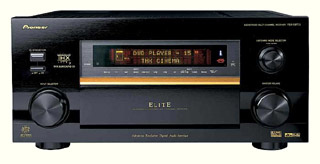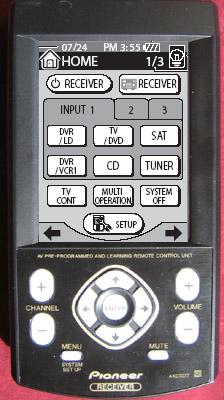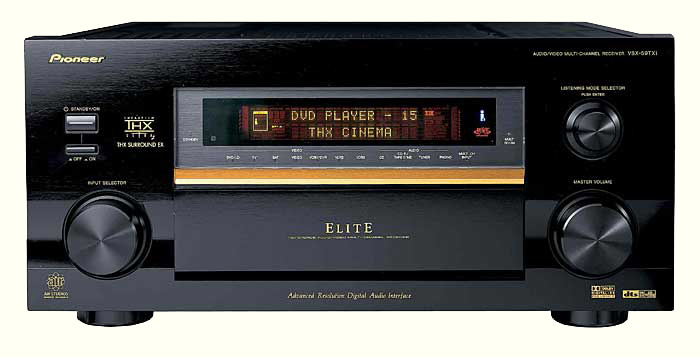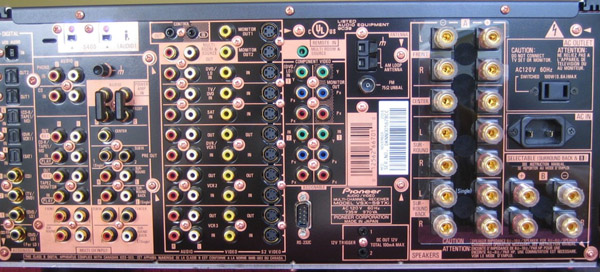|
|||||||||
|
Introduction Receivers are low-end, separates are high-end, right? Not so fast!! As Piero pointed out in his review of the Denon AVR-5805, the flagship receivers defiantly dispel this myth. Recently, I have been looking at purchasing some separates, but was not satisfied with what I found. So, I decided to take a look at Pioneer's current flagship 7.1 receiver, the Elite VSX-59TXi.
I own an Elite VSX-53TX so I am familiar with the
line. At over 68 pounds without the packaging, it is no lightweight to unpack. The front plate is gloss black with gold highlights. There are three knobs with a fold down cover for the rest of the controls, making a nice clean presentation. The speaker binding posts are high quality, and jacks are gold plated. It is extremely classy overall, but I prefer the symmetrical layout and more understated look of the 53TX. However, with all the features of the 59TXi, it is difficult to be symmetrical and understated.
Remote Control In addition, the remote has a built in rechargeable battery back and a supplied charging cradle, a very nice inclusion. OK, now the bad. I have three problem areas. First, the remote cannot be programmed via a computer or use any macros. Second, the displayed virtual button names can't be changed. This makes it an effort in memorization for learned components and doesn't jive well with the fact that all input names can be changed on the receiver itself. This means that when you change VCR2 to, say, Xbox on the receiver, you have to remember that the remote button tied to it remains as VCR2. Third, and most problematic, is the long response time and low transmission power output. Repeatedly, I found myself going back a menu because my button press didn't register with the receiver. Also, the update time from menu screen to screen is about one second, making quick navigation impossible. My roommate actually made a comment about how incredibly slow the remote is and that his commands don't always get received. Overall, I wish they would have either saved money on a cheaper remote (that we could discard in favor of a chosen programmable remote) or made some changes which would make it far more usable. As it is, the remote looks fairly expensive to manufacture, but lacking in functionality.
Set-up/Features
The set-up is easy, flexible, powerful, and feature-rich. The 59TXi features video transcoding (converts S-Video sources to component video). It works well, and I did not notice any artifacts worth mentioning. In fact, even though the run to my projector is 30 feet, the transcoded S-Video showed an increased clarity and sharpness when it was output as component video. However, this feature is for NTSC only. If you are in a PAL market, you need an output for each input type. There are three assignable component video inputs and one output. Component video frequency response is - 3 dB at 100 MHz, easily allowing for even high definition switching without signal degradation. I was disappointed that there was no HDMI or DVI support at all. Pioneer has a new flagship due later this year which will likely have HDMI support. In addition to the component connections, there are also seven S-Video and composite inputs and five outputs, in case you want drive several displays at the same time. There is one additional set on the front panel. If you have audio-video syncing problems, there is a group frame delay adjustment from 0 to 6 frames in 0.1 frame increments, so a total of 0.2 seconds maximum.
Audio There are three Toslink optical and three coaxial digital inputs in the rear (all assignable) with an additional Toslink optical input on the front. A USB jack accepts communication with a computer, and the Pioneer will decode WMA (Windows Media Audio). WMA is supported up with up eight channels at 48 kHz (bitrate limitation was not specified). My preferred digital audio connection is i.LINK, a non-proprietary IEEE1394 connection (in other words, everyone can use it). There is no limit to the number of components that can be daisy chained with i.LINK (well 17, or 63 with a repeater). What sold me on i.LINK was the combination of PQLS (Precision Quartz Lock System), giving completely jitterless playback and the ability to carry all DD, DTS, PCM, DVD-A, and SACD signals using just one cable. Combined with the Advanced MCACC calibration (explained in detail later), high resolution multi-channel sound has never sounded so amazing as it does with the 59TXi. I am very happy SACD is supported, and that all channels are on one cable (i.LINK), as set-up is much easier. There is the flexibility to use an alternate set of surround speakers for different sources, such as one pair for DVD-Audio, and another for movies if you wish. In addition, the front speakers can be bi-amped or bi-wired, and a second set of surrounds can be connected for bi-surround. There are connectors that can be removed to allow a separate stereo amp to be connected and seamlessly integrated with the remaining channels powered by the receiver. Additional settings include: Adjustable Dynamic Range Control, Bass Peak Level, Direct Stream (bypass processing), Multi-room, Adjustable Prologic II modes, THX Ultra2, Music Mode (for 7.1 playback on DVD-A and SACD), and Virtual Surround for Headphones. For bass management crossover settings, 50 Hz, 80 Hz, 100 Hz, 150 Hz, and 200 Hz are available, with an optional Plus setting for the subwoofer (summed main channel or separate).
There are no XLR balanced inputs or outputs. This is the star of the show, giving me hands down, the best sound I have heard in my room. What makes the auto set-up so easy is that all the user has to do is connect your components and speakers to the receiver, plug in the supplied microphone, and choose to start Auto Set-up on the menu. There are options to use the 80 Hz THX crossover setting regardless of speaker size, and if you want to use what Pioneer calls "X-Curve". (X-Curve is an attempt to deal with reverb effects of different frequencies in different rooms.) The receiver tests for background noise, speaker wiring (via phase), which speakers are connected, and their size (via freq response). When it is finished, you can select Data Copy to tweak the EQ anywhere you wish without disturbing the automatic calibration. The calibration goes a long way toward taking the room out of the equation. Of course, the more room treatments you have, and with careful speaker placement, the easier the receiver's job. However, every room has some limitations, including where the consumer can place the speakers, so that is where room correction comes in. I had five people listen on different days (including fellow writer Kris Deering) and everyone, without fail, greatly preferred the sound with the MCACC on. The 59TXi absolutely nailed the distances (0.2 foot increments) and levels (0.5 dB increments) of the main speakers (verified with tape measure and SPL meter). Imaging, bass clarity, tonal balance, and speaker timbre matching (identical speakers but different locations), were all greatly improved using the MCACC. The main speakers I used during the review were the excellent Onix Rocket RS-850s (review on the way). I had two of them sitting near me in the rear, with three up front and further away. The calibration knocked down the treble for the near speakers and bumped it up a bit for the front speakers. I am greatly simplifying it by the use of the word “treble” as there are nine bands of displayed user adjustable EQ. There were other changes in the spectrum, which all made sense due to the variations in my room. I ran the set-up a number of times and checked for consistency. Every now and then one band would report a decibel different than before, but by and large the settings were repeatable to 0.5 dB or better. I also tried just the center speaker at a variety of distances, and the closer I got to the speaker with the mic, the less EQ or adjustment was applied. So what does the Advanced MCACC have over the regular MCACC? Well, nine bands versus five for user adjustable EQ, along with X-Curve. Using a computer connected to the receiver and the supplied microphone, you can generate a reverb curve and adjust the window of time used for calibration, then change it for different frequencies. Some rooms have reverb more at higher frequencies, while others have it at lower ones. Using your computer, you can adjust the window by frequency until you have a flat curve. I didn't try out the function for myself, as I would have no idea how to improve what was done automatically. However, it is always nice to have pro-level functions like this; they give added flexibility, but do not get in the way for the average user. As I mentioned before, you can use the Data Copy feature to modify the EQ without changing the Auto EQ settings. The basic fully automatic setting tries to get your system to sound as close as possible to the Air Studios sound engineer's monitor reference system. If you have the front speakers sounding just like you want, you can do a “Front Align” to make all the speakers sound as close as possible to your main pair without EQ. All told you can have two manual custom settings and two automatically created settings (you could have one setting for each of several seating positions, for example). Other Features
There are some additional interesting features. The two 12
volt triggers activation can be changed for every input function. Also, inputs can be renamed to whatever the user wishes. When connected via i.LINK to the Pioneer DV-59AVi
DV player, the receiver will switch to the i.LINK
input when Play is pressed and the name is displayed. Also if you only have
two rear speakers, there is a “Virtual Surround Back” setting which lets you
have extended 6.1 or 7.1 information on a 5.1 system. I Repeat: Using the MCACC the sound was hands down the best I have heard in my room. By comparison, my older 53TX had just a touch of graininess and very slight digital glare. The Elite 59TXi is as good as or better than anything I have yet used. When I clicked on the MCACC calibration, I reached a new level. I finally had touched the emotional listening experience that can be so elusive. Kris Deering's latest setup has it, DTS's CES demo setup has it, and now I was having a taste right in my own less than ideal room. I had a couple buddies over who had heard my system previously and really enjoyed it, to see what they thought of my sound now. I used Laurence Juber's Guitar Noir and Eagles Hotel California DVD-Audio discs first. After maybe a minute they both had huge smiles and decided that they needed to get DVD-A for themselves. I can't remember all the superlatives they used, but the comments were along the lines of “Took my breath away”, “Almost brought tears to my eyes”, and “Can I bring my wife over to sell her on this?” Yep, it was that good. MCACC is not a gimmick or some hyped fad that will shortly disappear. Auto EQ is here to stay. Denon's flagship AVR-5805 has a more complicated and more advanced system using the Audyssey MultEQ XT, which would be nice to compare head to head. In addition, Yamaha has their YPAO, Harman Kardon has EZset/EQ, among others. Pioneer was one of the first to bring the current crop of room correction to consumer receivers. They have an excellent implementation, and quite frankly after hearing how well Advanced MCACC works, I won't settle for anything less.
The improvement
in my sound quality was so great, I won't buy another receiver or pre/pro
without room correction as a built-in feature. Imaging, tonal
balance, clarity, soundstage height, and width were all improved to the point
where, on the best recordings, they no longer sounded like recordings at all.
Pioneers Advanced MCACC is really something. Anyone and I mean ANYONE would be impressed with just how much of an
improvement was made by using it. The best part was that is was so intuitive
and simple to use. It should be obvious by now that I fell in love with the Pioneer VSX-59TXi 7.1 A/V Receiver. With incredible sound, awesome room correction, and flexible and powerful features, it is truly a performer. I kept the 59TXi in my system right to the very end of the review loan agreement.
When a piece of gear can
elicit emotional responses from people, you know you have something special. JJ,
please put me on the list as the one who gets to review their next flagship!
Equipment used in this review:
|
|||||||||


 any light.
In the photo at right, the screen image is simulated to show what one of the
menus looks like.
any light.
In the photo at right, the screen image is simulated to show what one of the
menus looks like.



